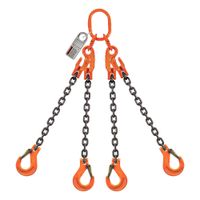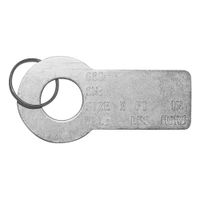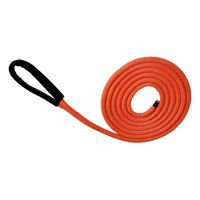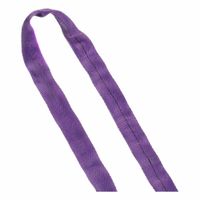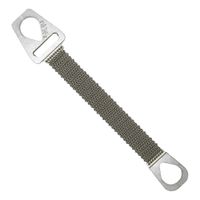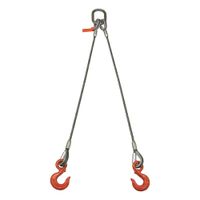Call +(254) 703 030 000 / 751 483 999 / 721 704 777
- Home
- Material Handling
- Lifting Pulling Positioning
- Lifting Slings
.....Read More
Frequently Asked Questions
What are the different types of lifting slings?
Lifting slings are essential tools in material handling and come in various types, each suited for specific applications. The main types include:
1. **Chain Slings**: Made from high-strength steel, chain slings are highly durable and resistant to abrasion, chemicals, and high temperatures. They are ideal for heavy-duty lifting and environments with harsh conditions. Chain slings can be adjusted for length and are available in different grades, such as Grade 80 and Grade 100.
2. **Wire Rope Slings**: Composed of multiple strands of steel wire twisted together, wire rope slings offer flexibility and strength. They are commonly used in construction and industrial settings for lifting heavy loads. Wire rope slings are available in various configurations, including single-leg, multi-leg, and braided.
3. **Synthetic Slings**: These include nylon and polyester slings, known for their lightweight and flexibility. They are gentle on delicate loads and are resistant to moisture and some chemicals. Nylon slings are elastic and absorb shock, while polyester slings have minimal stretch, making them suitable for precise lifting.
4. **Round Slings**: A type of synthetic sling, round slings are made from a continuous loop of polyester yarn encased in a protective cover. They are versatile, lightweight, and provide a strong grip on loads. Round slings are ideal for lifting cylindrical objects and are color-coded for easy identification of load capacity.
5. **Web Slings**: Constructed from woven synthetic fibers, web slings are flat and wide, distributing the load over a larger area. They are suitable for lifting delicate or finished surfaces without causing damage. Web slings are available in various configurations, such as eye-and-eye and endless.
Each type of sling has its advantages and limitations, and the choice depends on factors like load weight, shape, and environmental conditions.
How do you choose the right lifting sling for a specific load?
To choose the right lifting sling for a specific load, consider the following factors:
1. **Load Weight and Capacity**: Determine the weight of the load and select a sling with a working load limit (WLL) that exceeds this weight. Always account for any dynamic forces that may increase the effective load.
2. **Load Type and Shape**: Assess the load's shape, size, and balance. For irregular or sharp-edged loads, use slings with protective sleeves or corner protectors to prevent damage.
3. **Sling Material**: Choose the appropriate material based on the environment and load characteristics:
- **Nylon**: Flexible and strong, suitable for most applications but can be affected by chemicals and high temperatures.
- **Polyester**: Less stretch than nylon, resistant to acids, and suitable for environments where chemical exposure is a concern.
- **Wire Rope**: Durable and resistant to abrasion, ideal for heavy loads and harsh environments.
- **Chain**: Extremely strong and durable, suitable for high-temperature applications and heavy-duty lifting.
4. **Sling Type**: Select the sling type based on the lifting method:
- **Vertical**: For straight lifts.
- **Choker**: For securing the load tightly.
- **Basket**: For distributing the load across two legs.
5. **Environmental Conditions**: Consider factors like temperature, moisture, and exposure to chemicals. Ensure the sling material is compatible with these conditions to prevent degradation.
6. **Safety and Regulations**: Ensure compliance with industry standards and regulations, such as OSHA or ASME guidelines, to maintain safety and legality.
7. **Inspection and Maintenance**: Regularly inspect slings for wear, damage, or defects. Replace any sling that shows signs of wear beyond acceptable limits.
By evaluating these factors, you can select the most suitable lifting sling for your specific load, ensuring safety and efficiency in lifting operations.
What are the safety precautions when using lifting slings?
When using lifting slings, several safety precautions are essential to ensure safe and efficient operations:
1. **Inspection**: Before each use, inspect slings for damage such as cuts, frays, abrasions, or chemical exposure. Check for broken stitches in web slings and corrosion or deformation in metal slings.
2. **Load Limits**: Adhere to the manufacturer's rated load limits. Never exceed the working load limit (WLL) of the sling.
3. **Proper Sling Selection**: Choose the appropriate type of sling (chain, wire rope, synthetic, or mesh) based on the load's weight, size, shape, and environmental conditions.
4. **Correct Configuration**: Use the correct sling configuration (vertical, choker, or basket) for the load. Ensure the sling angle is appropriate to avoid overloading.
5. **Secure Attachment**: Ensure slings are securely attached to the load and lifting device. Use appropriate hooks, shackles, or other hardware.
6. **Balanced Load**: Ensure the load is balanced and stable before lifting. Adjust the sling as necessary to prevent tipping or shifting.
7. **Avoid Sharp Edges**: Protect slings from sharp edges using padding or edge protectors to prevent cuts or abrasions.
8. **Environmental Considerations**: Be aware of environmental factors such as temperature, chemicals, or moisture that may affect sling integrity.
9. **Clear Area**: Ensure the area around the lift is clear of personnel and obstructions. Use tag lines to guide the load if necessary.
10. **Proper Storage**: Store slings properly when not in use to prevent damage. Keep them clean and dry, and avoid exposure to direct sunlight or chemicals.
11. **Training**: Ensure all personnel involved in lifting operations are adequately trained in sling use, inspection, and safety procedures.
12. **Communication**: Maintain clear communication among team members during lifting operations to coordinate movements and address any issues promptly.
How do you inspect lifting slings for damage?
To inspect lifting slings for damage, follow these steps:
1. **Visual Inspection**: Examine the entire length of the sling for any visible signs of wear or damage. Look for cuts, frays, abrasions, or broken fibers in synthetic slings. For wire rope slings, check for broken wires, kinks, or corrosion. Chain slings should be inspected for bent, twisted, or stretched links.
2. **Check Labels and Tags**: Ensure that all identification tags are legible and intact. These tags provide critical information about the sling's capacity and specifications.
3. **Surface Wear**: Look for signs of excessive wear, such as thinning or deformation, which can indicate a reduction in strength.
4. **Chemical Damage**: Inspect for discoloration, brittleness, or stiffness, which may suggest chemical exposure. This is particularly important for synthetic slings.
5. **Heat Damage**: Check for signs of heat damage, such as melted or charred areas, which can compromise the sling's integrity.
6. **Hardware Inspection**: Examine any fittings, hooks, or attachments for cracks, distortion, or wear. Ensure that all components move freely and are not damaged.
7. **Load Test**: If necessary, conduct a load test to ensure the sling can handle its rated capacity. This should be done by a qualified professional.
8. **Record Keeping**: Maintain detailed records of inspections, including dates, findings, and any corrective actions taken.
9. **Frequency**: Conduct inspections before each use and perform thorough periodic inspections based on usage frequency and environmental conditions.
10. **Professional Evaluation**: If any damage is found, or if there is any doubt about the sling's condition, have it evaluated by a qualified professional. Do not use damaged slings.
Regular inspections help ensure safety and prevent accidents during lifting operations.
What are the advantages of using web slings?
Web slings offer several advantages in lifting and rigging applications:
1. **Flexibility and Versatility**: Web slings are highly flexible, allowing them to conform to the shape of the load. This adaptability makes them suitable for lifting a wide variety of objects, including those with irregular shapes.
2. **Lightweight**: Made from synthetic materials like nylon or polyester, web slings are lightweight, making them easy to handle, transport, and store. This reduces the physical strain on workers and increases efficiency.
3. **Non-abrasive**: The soft texture of web slings minimizes the risk of damaging delicate or finished surfaces of the loads being lifted. This is particularly beneficial when handling materials like glass, painted surfaces, or polished metals.
4. **High Strength-to-Weight Ratio**: Despite their lightweight nature, web slings offer a high strength-to-weight ratio, providing robust lifting capabilities without the bulk of traditional chains or wire ropes.
5. **Corrosion and Chemical Resistance**: Synthetic web slings are resistant to moisture, chemicals, and corrosion, making them suitable for use in various environments, including those that are wet or chemically active.
6. **Cost-Effective**: Web slings are generally more affordable than other lifting equipment, such as wire ropes or chains, making them a cost-effective choice for many industries.
7. **Safety**: The design of web slings reduces the risk of injury. They are less likely to cause cuts or abrasions to workers compared to wire ropes or chains. Additionally, they often come with color-coded capacities and wear indicators for easy inspection and safe use.
8. **Reduced Shock Loading**: The elasticity of web slings helps absorb shock loads, reducing the impact on both the sling and the load, which enhances safety and prolongs the lifespan of the equipment.
These advantages make web slings a popular choice in industries such as construction, manufacturing, and logistics.
How do you properly store lifting slings?
To properly store lifting slings, follow these guidelines:
1. **Clean Before Storage**: Ensure slings are clean and dry before storing. Remove any dirt, oil, or chemicals that could degrade the material.
2. **Temperature Control**: Store slings in a cool, dry place away from direct sunlight and extreme temperatures. Excessive heat or cold can weaken the material.
3. **Avoid UV Exposure**: Keep slings away from direct sunlight or UV light sources, as UV rays can degrade synthetic materials over time.
4. **Organized Storage**: Use racks, shelves, or hooks to hang slings. Avoid piling them on the floor to prevent damage from moisture or pests.
5. **Prevent Mechanical Damage**: Ensure slings are not in contact with sharp edges or abrasive surfaces that could cause cuts or abrasions.
6. **Separate by Type**: Store different types of slings (e.g., wire rope, chain, synthetic) separately to prevent cross-contamination and damage.
7. **Labeling**: Clearly label storage areas to easily identify sling types and capacities, ensuring quick access and reducing the risk of using the wrong sling.
8. **Regular Inspection**: Periodically inspect stored slings for signs of wear, damage, or degradation. Remove any damaged slings from service immediately.
9. **Avoid Chemical Exposure**: Keep slings away from chemicals or corrosive substances that could weaken or damage them.
10. **Proper Coiling**: For synthetic slings, coil them loosely to prevent kinks or twists that could weaken the fibers.
11. **Security**: Store slings in a secure area to prevent unauthorized access or theft.
By following these storage practices, you can extend the lifespan of lifting slings and ensure they remain safe and effective for use.
What are the common causes of lifting sling failure?
Common causes of lifting sling failure include:
1. **Overloading**: Exceeding the rated capacity of the sling can lead to failure. It's crucial to adhere to the manufacturer's load limits.
2. **Improper Use**: Incorrect sling angles, improper hitch types, or using the wrong sling for the job can cause undue stress and lead to failure.
3. **Wear and Tear**: Regular use can cause abrasion, cuts, or fraying in slings, especially in synthetic ones, compromising their integrity.
4. **Environmental Factors**: Exposure to extreme temperatures, chemicals, or UV radiation can degrade sling materials, particularly synthetic ones.
5. **Improper Storage**: Storing slings in damp, dirty, or chemically active environments can lead to deterioration.
6. **Lack of Inspection**: Failing to conduct regular inspections can result in undetected damage, leading to unexpected failures.
7. **Sharp Edges**: Contact with sharp edges can cut or damage slings, especially if edge protectors are not used.
8. **Twisting or Kinking**: Twisting or kinking slings can reduce their strength and lead to failure.
9. **Improper Repairs**: Using incorrect repair methods or materials can compromise sling integrity.
10. **Fatigue**: Repeated loading and unloading cycles can cause fatigue, especially in wire rope slings.
11. **Corrosion**: Metal slings can suffer from corrosion if exposed to moisture or corrosive substances, weakening them over time.
12. **Improper End Fittings**: Using incompatible or damaged end fittings can lead to sling failure.
13. **Human Error**: Lack of training or awareness can lead to improper handling and use, increasing the risk of failure.
